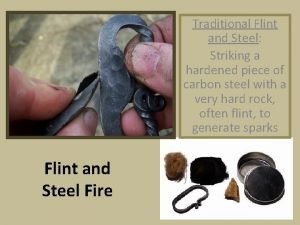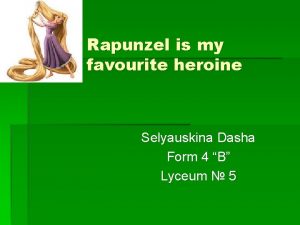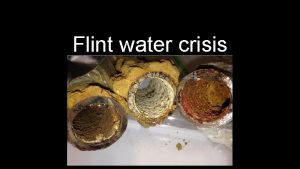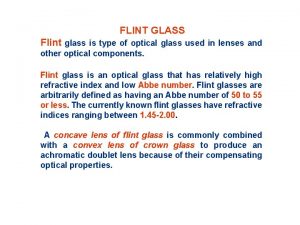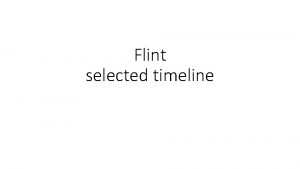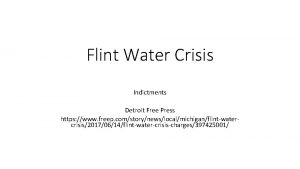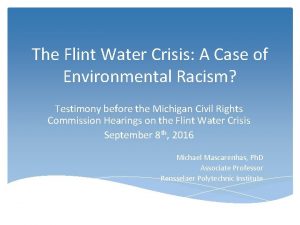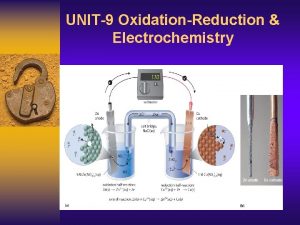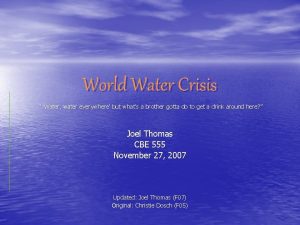The Flint Water Crisis An Introduction to Chemical



































- Slides: 35

The Flint Water Crisis: An Introduction to Chemical Reactions by Tracy J. Terry The University of New Mexico– Valencia Campus 1

By the end of this activity, you should be able to… 1. Identify the chemical reaction as precipitation, acid-base, or oxidation-reduction. 2. Write balanced chemical equations for each type of chemical reaction. 3. Use a solubility table to identify the products and spectator ions of precipitation reactions. 4. Identify the oxidation state of simple species (metals and simple non-metals). 5. Identify the oxidizing agent and reducing agent of redox reactions. 2

Pre-class assignment • Read your text about types of chemical reactions. • Read Chemical & Engineering News article from February 2016: http: //cen. acs. org/articles/94/i 7/Lead-Ended-Flints-Tap-Water. html • Answer the Reading Quiz questions. 3

Reading Questions 1. Which type of reaction involves the exchange of electrons between species? a. b. c. d. Acid-Base Reactions Precipitation Reactions Oxidation-Reduction Reactions Combustion Reactions 4

Reading Questions 2. Which type of reaction involves the exchange of hydrogen cations (H+) between species? a. b. c. d. Acid-Base Reactions Precipitation Reactions Oxidation-Reduction Reactions Combustion Reactions 5

Reading Questions 3. Which type of reaction involves the formation of solid species from a homogeneous aqueous solution? a. b. c. d. Acid-Base Reactions Precipitation Reactions Oxidation-Reduction Reactions Combustion Reactions 6

Reading Questions 4. Classify the following unbalanced chemical reaction: Na 3 PO 4(aq) + Fe. Cl 2(aq) Fe 3(PO 4)2(s) + Na. Cl(aq) a. b. c. d. Acid-Base Reactions Precipitation Reactions Oxidation-Reduction Reactions Combustion Reactions 7

Reading Questions 5. Classify the following unbalanced chemical reaction: Fe(s) + Cl 2(aq) Fe 2+(aq) + Cl-(aq) a. b. c. d. Acid-Base Reactions Precipitation Reactions Oxidation-Reduction Reactions Combustion Reactions 8

Reading Questions 6. Classify the following unbalanced chemical reaction: Fe(OH)2(s) + HCl(aq) Fe. Cl 2(aq) + H 2 O(l) a. b. c. d. Acid-Base Reactions Precipitation Reactions Oxidation-Reduction Reactions Combustion Reactions 9

Reading Questions 7. Classify the following unbalanced precipitation reaction: Fe 2+ (aq) + OH-(aq) Fe(OH)2(s) a. b. c. d. Complete Ionic Equation Molecular Equation Net Ionic Equation Spectator Ion Equation 10

Reading Questions 8. Which of the following was NOT a problem seen in Flint after the water source was changed? a. b. c. d. e. High levels of lead in the water Water-born bacterial disease outbreaks High levels of rust (iron) in the water Drought High levels of toxic trihalomethanes in the water 11

Reading Questions 9. What was the MAIN issue that led to ALL the problems seen in the Flint water supply? a. The high lead content in the Flint River b. Not controlling for the corrosion ability of Flint River water c. Lead containing pipes d. Iron containing pipes 12

Reading Questions 10. Dissolved oxygen and chlorine molecules act as a. Acids b. Bases c. Reducing agents d. Oxidizing agents e. Insoluble ions 13

Flint Water Supply: Before 2014 Cl 2 PO 43 Phosphate Corrosion Inhibitor Mineral Passivation Layer Cl 2 Cl. Cl 2 Passivation layer in metal pipes. Cl 2 • Flint’s water was supplied by Detroit. • Detroit added phosphate (PO 43 -) to the water to precipitate all metal cations. • These solids coat the inside of the pipes creating a passivation layer that protects the pipes from corrosion. • No exposed metal in pipes allows chlorine (Cl 2) levels to 14 remain stable.

Solubility Rules for Aqueous Ionic Compounds Generally Soluble Exceptions None Li+, Na+, K+, and NH 4+ NO 3 - and C 2 H 3 O 2 Cl-, Br-, and ISO 42 - None Compounds with Ag+, Hg 22+, or Pb 2+ are insoluble. Compounds with Sr 2+, Ba 2+, Pb 2+, Ag+, or Ca 2+ are insoluble. Generally Insoluble Exceptions S 2 - Compounds with Li+, Na+, K+, NH 4+, Ca 2+, Sr 2+, and Ba 2+ are soluble. OHCO 32 - and PO 43 - Compounds with Li+, Na+, K+, and NH 4+ are soluble. Compounds with Ca 2+, Sr 2+, and Ba 2+ are slightly soluble. Compounds with Li+, Na+, K+, and NH 4+ are soluble. 15

Flint Water Supply: Before 2014 11. Predict the precipitation product of the following reaction: Na 3 PO 4(aq) + Fe. Cl 3(aq) a. Fe 3(PO 4)2 d. Na. Cl b. Fe. PO 4 c. Fe 2(PO 4)3 e. PO 4 Cl 3 16

Flint Water Supply: Before 2014 12. Select the coefficients to balance the following chemical reaction: Na 3 PO 4(aq) + Fe. Cl 2(aq) Fe 3(PO 4)2(s) + Na. Cl(aq) a. b. c. d. 1, 1, 1, 3 2, 3, 1, 6 2, 3, 1, 3 2, 3, 1, 2 17

Flint Water Supply: Before 2014 13. Predict the precipitation product of the following reaction: Na 3 PO 4(aq) + Pb(NO 3)2(aq) a. Pb 3(PO 4)2 b. Pb. PO 4 d. Na. NO 3 e. PO 4 NO 3 c. Pb 2(PO 4)3 18

Flint Water Supply: Before 2014 Na 3 PO 4(aq) + Pb(NO 3)2(aq) 14. Identify the spectator ions in the chemical equation above. a. Na. Pb b. Na. NO 3 c. Na 3(NO 3)2 d. Pb. PO 4 15. Write net ionic equations for the chemical equation above. (Worksheet only) 19

Flint Water Supply: Before 2014 Mineral Passivation Layer Cl 2 PO 43 Cl. Phosphate Corrosion Cl 2 Inhibitor Cl 2 Metal pipe with passivation layer Phosphate in the water also reduced the acidity of the water. PO 43 -(aq) + H 2 O(l) HPO 42 -(aq) + OH-(aq) creating OHPO 43 -(aq) + H+(aq) HPO 42 -(aq) removing H+ PO 43 -(aq) + H 3 O+(aq) HPO 42 -(aq) + H 2 O(l) 20

Flint Water Supply: Before 2014 Mineral Passivation Layer Cl 2 PO 43 Cl. Phosphate Corrosion Cl 2 Inhibitor Cl 2 Metal pipe with passivation layer • Basic conditions protect the passivation layer • Acidic conditions dissolve the passivation layer. Basic conditions: Pb 2+(aq) + 2 OH-(aq) Pb(OH)2(s) Acidic conditions: Pb(OH)2(s) + 2 H+(aq) Pb 2+(aq) + 2 H 2 O(l) 21

Flint Water Supply: Before 2014 (Worksheet only) 16. Predict the products and balance the following reactions: a. Na 3 PO 4(aq) + HCl(aq) b. Pb(OH)2(s) + HCl(aq) c. Fe(OH)3(s) + HCl(aq) 22

Flint Water Supply: After switching to Flint River water – April 2014 Flint’s water supply was switched to the city’s own water treatment plant on the Flint River. • Phosphate (PO 43 -) was NOT added to the Flint River water in the new plant. Affects on passivation layer: • Lack of phosphate (PO 43 -) prevents removal of dissolved Fe 2+/3+ & Pb 2+/4+ • Acidic river water directly dissolves passivation layer by neutralizing OH- Result: The passivation layer dissolved, exposing the metal pipes. 23

Exposed metal pipes react with Cl 2 & O 2 Cl- Cl. Cl 2 O 2 Cl 2 Pb 2+ Cl 2 Cl. Pb 2+ O 2 Lead Pipe Lead is oxidized by dissolved oxygen (O 2) and it is difficult to detect. 2 Pb(s) + O 2(aq) + 4 H+(aq) 2 Pb 2+(aq) + 2 H 2 O(l) 2 Fe(s) + O 2(aq) + 4 H+(aq) 2 Fe 2+(aq) + 2 H 2 O(l) Fe(s) + Cl 2(aq) Fe. Cl 2(aq) Cl- Cl- Cl 2 Cl. Fe 2+ O 2 Cl- Cl. Fe 2+ Iron Pipe Iron is oxidized by dissolved oxygen (O 2) and chlorine (Cl 2). It turns the 24 water rust colored.

Flint Water Supply: After 2014 17. Identify the oxidation state of each species in the balanced chemical equation: Fe(s) + Cl 2(aq) Fe. Cl 2(aq) i. Fe(s) ii. Cl 2(aq) a. 0 b. 1+ c. 2+ d. 1 - e. 2 - iii. Fe in Fe. Cl 2(aq) a. 0 b. 1+ c. 2+ d. 1 - e. 2 iv. Cl in Fe. Cl 2(aq) a. 0 b. 1+ c. 2+ d. 1 - e. 225

Flint Water Supply: After 2014 Identify redox species in the redox equation: Fe(s) + Cl 2(aq) Fe. Cl 2(aq) 18. The species that gets reduced is the a. Fe(s) b. Cl 2(aq) c. Fe in Fe. Cl 2 d. Cl in Fe. Cl 2 19. The species that gets oxidized is the a. Fe(s) b. Cl 2(aq) c. Fe in Fe. Cl 2 d. Cl in Fe. Cl 2 26

Flint Water Supply: After 2014 Identify redox species in the redox equation: Fe(s) + Cl 2(aq) Fe. Cl 2(aq) 20. The oxidizing agent is the a. Fe(s) b. Cl 2(aq) c. Fe in Fe. Cl 2 d. Cl in Fe. Cl 2 21. The reducing agent is the a. Fe(s) b. Cl 2(aq) c. Fe in Fe. Cl 2 d. Cl in Fe. Cl 2 27

The Switch to Flint River Water Cl- Cl- Cl 2 X Cl. Fe 2+ Exposed iron reduces chlorine. O 2 X Cl- Cl. Fe 2+ Water becomes rust colored. Iron Pipe The reduction of chlorine (Cl 2) and oxidation of iron (Fe) encourages bacterial growth. Chorine (Cl 2) is added to water to kill bacteria. Cl 2 is being reduced by the exposed iron pipes: Cl 2 + 2 e- 2 Cl. The iron is being oxidized by the chlorine: Fe(s) Fe 2+ + 2 e. Both Legionnaires and E coli bacterial infections increase in Flint. Bacteria thrive in a high Fe 2+/Fe 3+ environment. 28

After switching to Flint River water Cl- Cl. Cl- Fe 2+ Cl. Pb 2+ Cl- Cl. Cl- Pb 2+ Fe 2+ June 2014 – Legionnaires infections begin appearing in Flint 2014 87 people infected - 10 died Flint annual normally: 6 -13 infections *http: //www. forbes. com/sites/judystone/2016/01/14/legionnaires-disease-compounds-flints-leadpoisoning-water-crisis/#f 82 ea 01702 df Other bacterial outbreaks occur during 2016 due to lack of hand washing by residents suspicious of the water. *http: //www. cnn. com/2016/10/03/health/flint-water-shigellosis-outbreak/ 29

Water analysis before and after return to Detroit water supply in 2016. EPA action limit: 90 th percentile lead levels below 15 ppb In other words: 90% of samples below 15 ppm In other words: If >10% of tap water samples have lead levels over 15 ppb, the EPA requires the water provider to take action. A Jan 2017 study resulted in a 90 th percentile lead level of 12 ppm for Flint. - under the EPA action limit *http: //www. nbcnews. com/storyline/flint-water-crisis/water-lead-level-falls-below-federal-limit-flint-n 711716 30

Timeline April 2014 – City of Flint, MI switches water supplies to Flint River. Sept 2015 – Flint pediatrician reports increases in lead poisoning of Flint children. June 2014 – Cases of Legionnaires disease begin occurring in Flint. Oct 2014 – General Motors quit using Flint, MI water due to high levels of corrosion. Feb 2015 – City finds >100 ppb lead levels in one resident’s home. Aug 2015 – VA Tech group: Flint’s 90 th percentile lead level Jan 2015 – Detroit offers is 25 ppb. to reconnect water supply March 2015 – Environmental review with Flint – offer declined. recommends Flint add corrosion inhibitor to water. 31

Review Questions 22. What led to the dissolution of the passivation layer, exposing of the metal (Pb and Fe) pipes? a. Less phosphate = fewer insoluble anions in solution b. Less phosphate = more soluble anions in solution Put a theta (θ) next to the relevant reactions on your worksheet. 32

Review Questions 23. What led to the dissolution of the passivation layer, exposing of the metal (Pb and Fe) pipes? a. Less phosphate = more acidic water, acids dissolve passivation layer by neutralizing OH-, a mostly insoluble anion b. Less phosphate = more basic water, bases dissolve passivation layer because OH- is a mostly soluble anion Put a pi (π) next to the relevant reactions on your worksheet. 33

Review Questions 24. What led to the release of Fe and Pb from the exposed pipes? a. dissolution with increased acid (H+) content b. dissolution with soluble anions (more Cl-, less PO 43 -) c. dissolution by oxidation with chlorine and oxygen Put a star (*) next to the relevant reactions on your worksheet. 34

Related Resources Torrice, Cecil Michael “How Lead Ended Up In Flint’s Tap Water”, C & E News, Vol 94(7), pp 26 -29. Web Date: Feb 11, 2016. http: //cen. acs. org/articles/94/i 7/Lead-Ended-Flints-Tap-Water. html http: //cen. acs. org/articles/94/i 7/Lead-Ended-Flints-Tap. Water. html? utm_source=UNM&utm_medium=Partner&utm_campaign=CEN Davenport, Matt “Lead levels remain high in Flint’s water”, C & E News, 94(16), April 15, 2016 http: //cen. acs. org/articles/94/i 16/Lead-levels-remain-high-Flints. html http: //flintwaterstudy. org/ http: //www. nbcnews. com/storyline/flint-water-crisis/water-lead-level-falls-below-federal-limit-flint-n 711716 Bacterial outbreaks: http: //www. cnn. com/2016/10/03/health/flint-water-shigellosis-outbreak/ http: //www. forbes. com/sites/judystone/2016/01/14/legionnaires-disease-compounds-flints-lead-poisoningwater-crisis/#f 82 ea 01702 df Maynard, J. B. “Overview of Lead Scale Formation and Water Solubility: http: //www. sedimentaryores. net/Pipe%20 Scales/Lead%20 Scale%20 Formation%20 and%20 Solubility%20%20 overview. pdf http: //www. sedimentaryores. net/Pipe%20 Scales/Lead%20 Solubility. html Flint’s Water Crisis and the ‘Troublemaker Scientist’ https: //www. nytimes. com/2016/08/21/magazine/flints-water-crisis-and-the-troublemaker-scientist. html? _r=0 35
 Water and water and water water
Water and water and water water Cholinergic crisis
Cholinergic crisis Austin flint murmur
Austin flint murmur Ast levels and exercise
Ast levels and exercise Rics
Rics Dynamic auscultation
Dynamic auscultation Chapter 13 flint
Chapter 13 flint Flint health and wellbeing centre
Flint health and wellbeing centre Hardened piece of steel
Hardened piece of steel It consulting flint
It consulting flint Flint ink closing
Flint ink closing The basic building block of the silicate minerals
The basic building block of the silicate minerals Richard flint england golf
Richard flint england golf Flint hills regional council
Flint hills regional council White flint sector plan
White flint sector plan Um flint rec center
Um flint rec center Tlc pediatrics flint
Tlc pediatrics flint Flint rotary club
Flint rotary club Flint rapunzel
Flint rapunzel Pmi flint
Pmi flint Yengn
Yengn Section 2 classifying chemical reactions
Section 2 classifying chemical reactions Empirical formula and molecular formula pogil
Empirical formula and molecular formula pogil Chemical reactions section 2 classifying chemical reactions
Chemical reactions section 2 classifying chemical reactions Chemical reactions section 1 chemical changes
Chemical reactions section 1 chemical changes Love formula
Love formula Are kc and kp equal
Are kc and kp equal Hình ảnh bộ gõ cơ thể búng tay
Hình ảnh bộ gõ cơ thể búng tay Lp html
Lp html Bổ thể
Bổ thể Tỉ lệ cơ thể trẻ em
Tỉ lệ cơ thể trẻ em Gấu đi như thế nào
Gấu đi như thế nào Tư thế worm breton
Tư thế worm breton Hát lên người ơi alleluia
Hát lên người ơi alleluia Các môn thể thao bắt đầu bằng tiếng bóng
Các môn thể thao bắt đầu bằng tiếng bóng Thế nào là hệ số cao nhất
Thế nào là hệ số cao nhất








